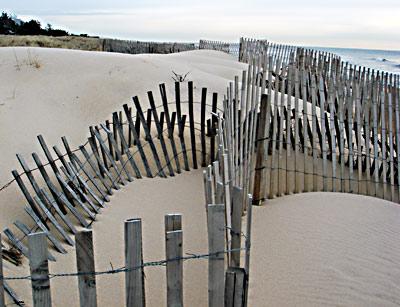Town Trustees Consider Beach Fences

East Hampton Town Trustees are concerned that the beach is eroding in two directions: from the seaward side due to the ocean’s rise and intermittent storm surges, as well as from the landward side via creeping sand fences put up by beachfront homeowners.
Assuming that Stuart Vorpahl, a local history scholar, is correct, the word “beach” meant something very different in East Hampton’s early days. As a geographical reference, beach began where arable land stopped, that is, at the landward side of the dunes, he says. In more modern times, the beach is defined either as the stretch of sand between the sea and the seaward edge (or toe) of the dunes or between the sea and mean high water.
The sandy domain reserved for the public is dependent on these definitions.
During the last year, the trustees have been fighting three State Supreme Court battles with oceanfront owners over beach access. The trustees also have embarked on an effort, in cooperation with the town’s Natural Resources Department, to control the location of sand fences.
At a meeting on Tuesday night, Joe Bloecker, one of the trustees, reported he had filed a complaint with the town’s Code Enforcement Department over four sections of fencing (with video cameras peering down from their two-by-four supports) that have been placed perpendicular to the shoreline in front of the White Sands Motel on Napeague.
The nine-member board has also gone after Napeague property owners on nearby Marine Boulevard. Several years ago, the trustees, in cooperation with East Hampton Village, set about removing fences they called illegal. But such fences have kept on coming — sometimes even as one, two, and more fences erected in front of each other — encroaching on public beach.
Sand fences and snow fences are the same thing, and, in most places, the flexible wire-and-lathe structures work. Originally designed to trap blowing snow, they attract sand in the same way. Wind-driven sand tends to pile up on both the leeward and windward sides, making them effective at rebuilding eroded dunes.
However, because erosion along many of the South Fork’s beaches has become chronic, the private-public line in the sand has become blurred. This became a matter of public debate in the fall when Molly Zweig erected a fence made of steel poles to mark the boundary of her upland property at Georgica Beach in the village.
Before a series of storms stole much of the sand there, access to the beach was no problem. The oceanfront boundary of Ms. Zweig’s property was neither acknowledged nor marked. But when the beach grew narrow and she put up a fence that threatened to block public access, officials cried foul.
State and local regulations on beach fences reflect each other. East Hampton Village’s law mirrors those of the town and recognizes the trustees’ authority. The village has charged Ms. Zweig with putting up fencing without a permit, but has decided against raising the issue of her property’s seaward boundary.
The conflict between what Ms. Zweig’s deed indicates and the public’s right of access to the beach at Georgica has focused attention on a general dilemma: When dunes are washed away, leaving only a narrow strip of sand, does the sand become public or remain private? For now, the trustees are thinking about the issue the opposite way: Does dune that has grown seaward with the help of sand fencing become private property? In the trustees’ opinion the answer is “no way.”
Diane McNally, the trustees clerk, believes the rules about shoreline fencing in the town code need to be better enforced, and perhaps amended.
“The ins and outs of the law are not being followed, and I’m told by contractors that the permit process is onerous. People don’t want to have to provide updated surveys every time. Meanwhile, fences are going up left and right. A lot of it is dune restoration, but others are not.”
The installation and maintenance of fences on town beaches is detailed in section 255-4-70.2 of the code. A $60 fee to apply for sand fencing is paid to either the trustees or, in the case of Montauk beaches, to the Highway Department because the trustees do not have jurisdiction there.
According to the town’s rules, permits for sand fences used for dune restoration expire after one year. Seasonal erosion control fencing must be removed no later than March 15 in any given year. Seasonal fencing also must be lifted and re-exposed whenever it becomes half covered with sand.
Other requirements are that sections of fence be no longer than 10 feet, be placed at a 45-degree angle to the shoreline, be no farther than 10 feet seaward of a dune, and be supported by untreated wood stakes. In addition, fencing is not to interfere with nesting areas.
Because untended fences often wind up in snarls after storms, the trustees would like to see lathes branded in some way to identify them. Ms. McNally said she would like to see the lathe strung together with a biodegradable material, hemp perhaps, instead of steel wire. She said fences constrain the public in another way.
“Whatever is behind the fence looks like it’s private even if it’s not. It’s a mind-set, subtle and instinctual. ‘Something there is that doesn’t love a wall,’ Robert Frost, I think.”
